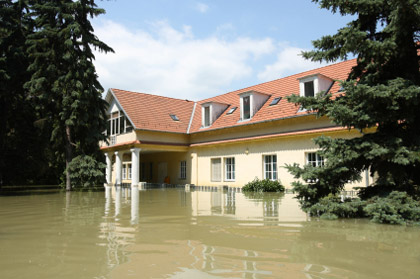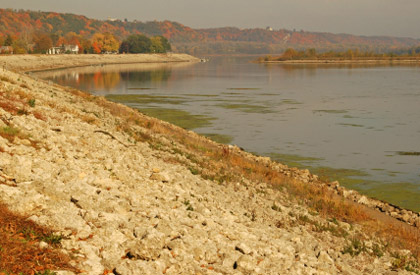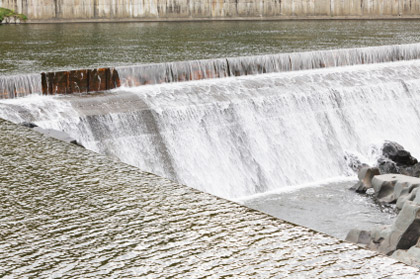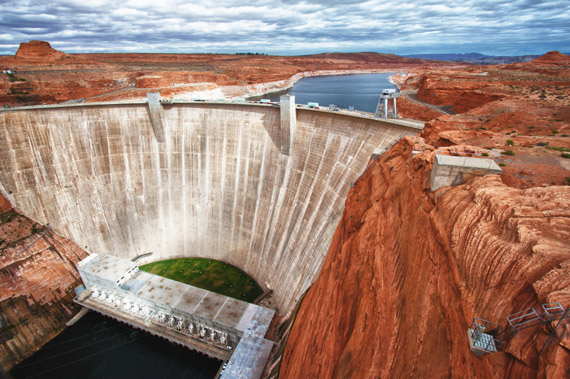Resources for the Future: Securing Water for a Secure Future
Perusing headlines across the United States, the poetic refrain of Samuel Coleridge comes to mind: “Water, water everywhere, nor any drop to drink.” The refrain referenced oceans, but it seems increasingly applicable as many parts of the United States and the globe struggle with water challenges. A national report a few years ago opined that “abundant supplies of fresh drinking water can no longer be taken for granted.” In her 1998 book, The Last Oasis: Facing Water Scarcity, Sandra Postel notes that the number of water-stressed countries is expected to jump six-fold over three decades.
While not all issues I faced while at the U.S. Department of the Interior (DOI) from 2001 to 2009 were water issues, many of the most contentious included water as a central source of conflict. The Klamath Basin hit the headlines shortly after I arrived in Washington in 2001. Hydropower, endangered species, agriculture, fisheries and tribal heritage all converged on a collision course centered on water. As I left DOI in 2009, the Bay Delta in San Francisco was in the headlines and careening toward calamity as resource managers considered the fate of delta smelt, salmon, wetlands conservation, municipal water, agricultural irrigation and flood control. Glen Canyon Dam, Lake Powell and Lake Mead all face contests over power supplies, irrigation, recreation, endangered species and cultural resources.
Even in the East, the Interior Department found itself amid battles among Georgia, Florida and Alabama over water flows in the Apalachicola, Chattahoochee and Flint watersheds in a tug of war over the water needs of municipalities, agriculture, hydropower generators, endangered species and ecosystems more broadly. Throw a dart on the map, and we see communities that face water challenges. Laws, regulations, markets, cultures and technologies all converge as these challenges unfold.
These challenges are not new, and they have a long history of finding their way into popular culture. Back in the 19th Century, Mark Twain reportedly quipped that “whiskey’s for drinking; water’s for fighting about.” This sentiment was captured a century later in the 1974 film Chinatown, depicting battles over water in California’s Owens Valley as a thirsty Los Angeles strived to secure water supplies. But, water challenges may increase in frequency, form and intensity as they spark unprecedented actions to anticipate and to manage shortages. In 2007, for example, for the first time since the Colorado River compact among the seven user states was crafted in the 1920s, those states signed a shortage-sharing agreement.
21st Century Water Challenges

© iStockphoto.com/kgfoto
Several trends complicate 21st Century water management challenges. Perhaps none is more perplexing than climate change and its effects on water. Annual precipitation for most of North America is increasing, but some of that rainfall is occurring as heavy downpours that cause flooding and sewage overflows in urban drainage systems. The eastern United States has experienced a 58 percent increase in heavy rainfall events within the past 50 years. Perhaps a bellwether of the future, April and May 2011 brought historic flooding to much of the Mississippi River watershed. On a single day in May more than 100 locations experienced major or moderate flooding.
Elsewhere, climate change may increase drought severity. National Center for Atmospheric Research maps show big swaths of bright red patches reflecting areas expected to experience future drought conditions. The projections show much of the Western Hemisphere, large parts of Eurasia, Africa and Australia threatened by extreme drought this 21st Century. This means trouble for cities, industries and farmers who need water for basic consumption needs. Urbanization, saltwater intrusion into water supplies, ongoing contamination, allocation of water resources that exceeds supplies, continued groundwater extraction from artesian basins, demands on water from energy production and population growth all impact water quality and quantity.
Changes in water availability and storm intensities also stress water infrastructure. Generally, 20th-Century water flows were unusually stable. United States laws and practices for managing water largely emerged in this relatively stable context. And, the Nation’s infrastructure was sized to handle water flows and to deliver stored water during this period of relatively stable conditions.
What’s the bottom line of this brief tale? Across the North American Continent, climate changes may result in some places being wetter, some drier. Some locations will have more snowfall, some less. Some will experience more extended and intense drought, other places less severe droughts. And these changes are all unfolding – nationally and globally – in a context of aging or insufficient infrastructure, increasing demands for water, institutional structures that often lack nimbleness and decision making processes that segregate water management into silos of drinking water, stormwater, flood management, wastewater and storage.
Despite many geographic variations, some key themes emerge and present implications for response strategies. Consider water supply infrastructure (including reservoir operations, flood control and stormwater management). The United States already confronts aging water infrastructure. But, thinking about how to replace or to upgrade that infrastructure brings new challenges – and new opportunities. Changes in flows, intensity and timing of precipitation and changes in the timing and magnitude of runoff affect diversion, storage, flood control and conveyance structures.
Old-style levees may not be up to the task of protecting communities. In 1997, more than 30 levees in California broke and spilled flood waters that killed nine people. While I was at the Interior Department, a levee failed, which caused then Gov. Schwarzenegger to demand a closer look at the hundreds of miles of levees in the state. Compounding the prospects of more levee failures is the sinking of lands drained within the past hundred years to turn wetlands into farmlands. Lands in some areas have dropped more than 25 feet, which is stressing levees and leaving communities vulnerable to disaster if these levees break.

©iStockphoto.com/PhilAugustavo | Levee for flood control on the Mississippi River in Iowa.
Midway across the nation, the U.S. Army Corps of Engineers deliberately blasted a hole in a levee in Mississippi County, Missouri, when it became clear levees up and down the river simply could not keep floodwaters away from people. Though the Corps had anticipated this possibility years ago in planning the levee, it nonetheless faced a Faustian choice: Breach the levee and displace several hundred families, or keep the levee intact to save the larger community of Cairo, Illinois, and the remaining levee system. When the Corps breached the levee, critics of the levee system dusted off arguments in favor of restoring natural floodplains, using Nature to store water while keeping people out of harm’s way.
Nature as a Solutions Provider
Many water managers face tough questions about whether to keep on building bigger, tougher levees or consider ways to reintroduce more natural river system functioning and flow patterns to meet human needs while improving ecological functioning and climate resilience. Tools for achieving these goals include flexible river management to revise operational plans of dam systems to create more natural flow regimes and stream temperatures, to improve fish passage and migration through pulse flows, and to provide controlled release of floodwaters with increased use of floodplains. A handful of partnerships between The Nature Conservancy and Army Corps of Engineers are reintroducing Nature into the water management equation along the Green River in Kentucky and in other river systems in Vermont, New Hampshire, North Carolina, Virginia, Georgia, South Carolina, Texas, Louisiana, Arkansas, Missouri, Arizona, Oregon, Pennsylvania and Colorado.
While I was at the Interior Department, the Fish and Wildlife Service (FWS) began working on a Reservoir Fisheries Habitat Partnership. Reservoirs in the United States have four primary functions that include: provision of hydropower, flood risk reduction, irrigation and drinking water. Reservoirs also provide many other ecosystem service values such as wildlife and fish habitat, aquaculture, recreation and aesthetic values. The FWS reservoir partnership calls for working with communities to manage upstream, reservoir and downstream waters as a whole system to better fulfill a full suite of ecosystem services. Tools in this strategy include floodplain restoration, at least in part, increased use of reservoir storage space rather than maintaining flood management capacity, and implementation of more natural flow regimes in rivers.
Cities, too, are taking another look at Nature as they strive to manage secure adequate supplies of clean, fresh water and reduce stormwater impacts. Philadelphia, for example, is betting on urban greening to buy cleaner, cheaper, smarter water management solutions. Their green toolkit includes use of increased permeable surfacing, re-establishment of more natural river forms and flows, use of bioswales and other techniques that take advantage of natural rather than highly engineered built structures.
Urban water use and water management often remain locked within limitations of old infrastructure. This infrastructure has contributed to increased stormwater runoff and has not facilitated water conservation. With paving of city surfaces has also come a loss of tree cover in urban areas. Yet trees help manage stormwater by intercepting rainfall and slowing the rate at which it runs over the surface of the land and seeps into the ground. The loss of urban trees, by some estimates, has cost cities $100 billion in increased stormwater management needs.

© iStockphoto.com/stevegeer
Restoring permeable surfacing and expanding tree canopy in cities can significantly reduce stormwater runoff and associated contaminants from entering urban streams. With some climate models projecting increased frequency of high-intensity rainfall events, reducing stormwater becomes increasingly salient to cities. In this context, urban greening presents a potentially important strategy. Existing infrastructure also results in extensive missed opportunities for water conservation. Most city infrastructure distributes potable drinking water for all urban water needs from drinking water to laundry to toilet flushing to landscape irrigation. Residential water consumption in the United States was estimated at 161 gallons per capita per day in 1996-1998. That figure is fourfold higher than in many European nations.
Market-Based Pricing Mechanisms
Some of the high U.S. water consumption may be linked to low-priced water rates. Several cities have begun to use tiered block pricing with rates climbing as use climbs. Evaluation of such tiered pricing indicates corresponding per capita declines in water use. Though many water utilities or large water projects use cost-of-service water pricing, increasingly water purveyors in areas facing chronic drought or constrained supplies are applying conservation-based pricing. A 2010 review of water utility pricing in Florida, for example, shows 14 of 16 water utilities using conservation-based pricing. Use of conservation pricing in water-constrained states in the western United States is also increasing.
Yet greening – whether of infrastructure or in pricing patterns – confronts policy and legal challenges in the United States. Clean Water Act compliance standards and metrics are typically premised on meeting specific infrastructure capacity requirements or other technical prescriptions. “Greening” presents an entirely different framework for managing water, one that does not readily fit into EPA’s enforcement models for water management. Changing water availability may also stretch the capacity of existing compacts and rights allocations and the effectiveness of “prior appropriation” water rights in allocating water in circumstances of scarcity, thereby provoking, as in the case of the Colorado River shortage-sharing agreement, a reexamination of some long-standing legal compacts and concepts.
What do all these challenges portend? Several policy and management tools become increasingly important. In a context of climate change, increasing water demands and pressures to improve water quality, water management strategies that introduce market concepts and flexibility may be increasingly relevant. Watershed permitting and trading present growing opportunities for improving water management in terms of both supplies and quality. Some voluntary trading has occurred, and states like Pennsylvania, Virginia and Maryland have supported trading through state statutes.
Benefits of water quality trading can be considerable. In the Tualatin Basin, Oregon, four wastewater permits and one stormwater permit were required. The water services district needed additional measures to meet water temperature standards. Their primary options included spending $60 million on a refrigeration system or spending $6 million to pay farmers to plant trees along 37 miles of streams using a permit credits approach. The example illustrates the potential both of a watershed approach and the utility of water quality credits and trading. Use of another tool, water transfers, is already extensive. One such database in 12 western states between 1987 and 2010 identifies approximately 4,400 water transfers. The World Resources Institute identified 57 water-quality trading programs worldwide in 2009, with only six of these active outside the United States.

© iStockphoto.com/Willowpix
While these market-based policy and pricing tools vary in purpose and design, their focus is on achieving three primary goals: reallocation of water flows, water conservation and improved waterquality. But effective use of these tools is often constrained by the dispersed water management authorities, multiple agencies and diverse jurisdictions that make coordination and market trading. These fractured authorities and structures also limit opportunities for water managers to bring a more holistic lens toward managing water quality, water supplies, stormwater and wastewater management, and flood control. For example, the Chesapeake Bay is situated among some 128 different municipalities. The Walla Walla Washington Watershed Council presents an institutional model aimed at addressing some of these issues.
A New Water Management Paradigm
The challenges of rethinking water management are illustrated by efforts to resolve Klamath Basin water challenges. While I was at the Interior Department, Michael Bogert, Counselor to the Secretary, worked on development of “Principles” for a Klamath Basin Restoration Agreement. The discussions involved 50 different signatories representing 50 federal, state, local, tribal and private entities. Actual negotiations included 26 different organizations. The principles under consideration included removal of four dams, restoration of natural fish species dynamics, continued opportunities for ocean and river fish harvesting, reliable water and power supplies for agriculture, communities, wildlife refuges and the overall public welfare. The Obama Administration signed a Klamath Basin Agreement largely forged from these initial discussions.
Each of these elements is extremely complicated. Fish species enhancement includes reintroduction of anadromous species at certain locations and adaptive management and monitoring. Actions would occur throughout a 30-year period or more. Proposals include a permanent increase in water for fish management, obligations for more water conservation through a water use retirement program and more water storage through land management and banking. The proposals include groundwater management and drought management. Overall, the initial Klamath Basin restoration discussions involved 57 high-level actions and a multitude of sub-actions. To accomplish all of these actions requires new legislation in two states, bond measures, billions in federal funding, new federal authorities for the Bureau of Reclamation, water rights assurances and resolution of water rights claims. These efforts would require creation of a cross-jurisdictional governance council.
As I contemplate the Nation’s water future, the Klamath Basin is a precursor to the kinds of complexities we can expect. These complexities will require: 1.) an intensified use of science to understand system dynamics and evaluate management options, 2.) policy tools focused at the watershed and landscape scales, 3.) tools that strengthen adaptive responses and conservation incentives, and 4.) mechanisms to enhance network or multi-jurisdictional coordination.
The U.S. Geological Survey, summing up vital statistics of global water supplies, observes that the “Earth is a watery place,” with some 70 percent of the Earth’s surface covered in water. But more than 96 percent of that water is ocean saltwater, and much of the freshwater is not accessible. Still, many areas of the United States (and the globe) have extensive freshwater resources. Yet, water security cannot be measured in drops of water. Rather, water security ultimately resides in how landowners, communities and nations access and manage water. Therein lay our most significant challenges.

© iStockphoto.com/AlexeyKamenskiy




























